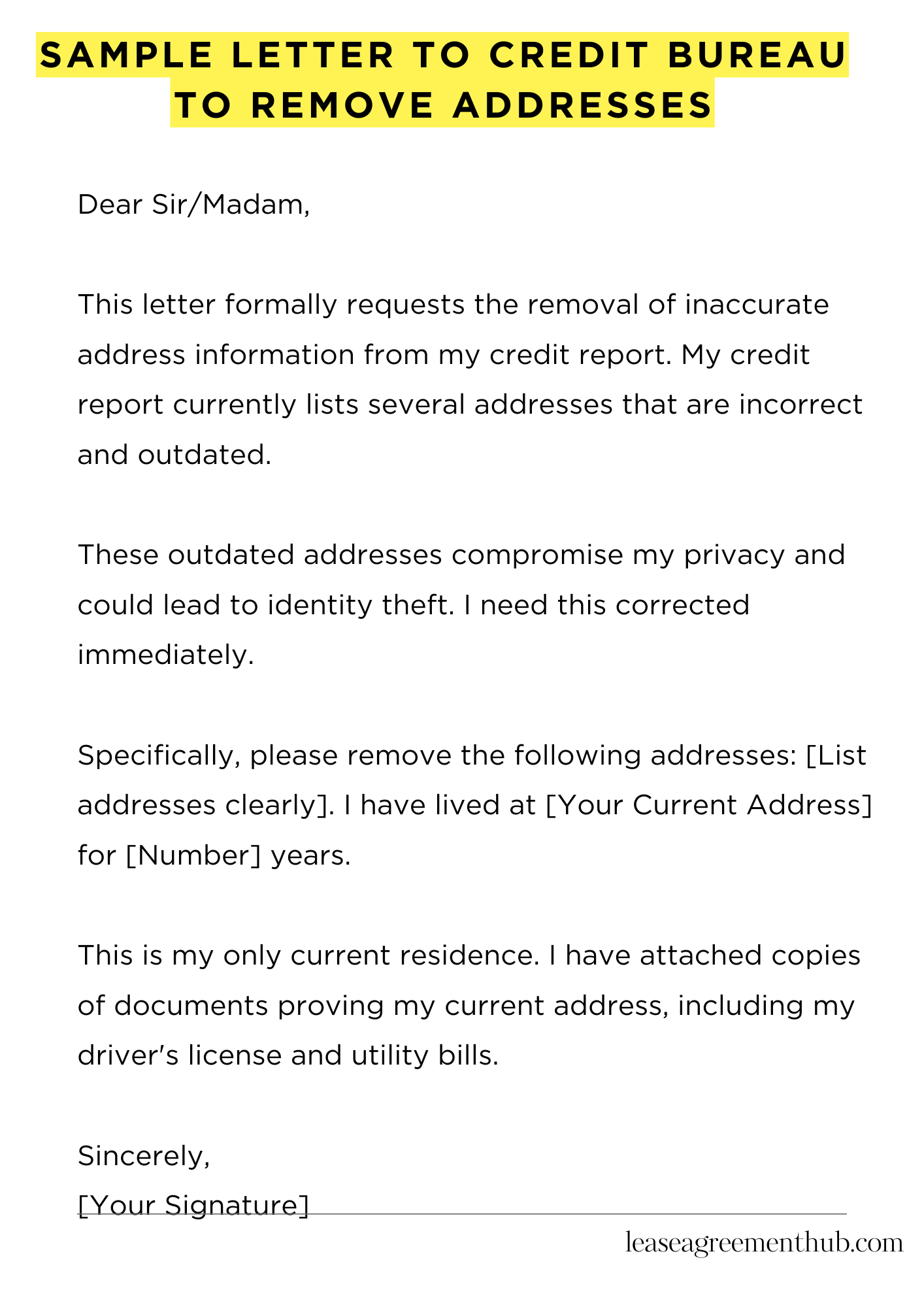A sample letter to a credit bureau helps remove incorrect addresses from your credit report. This is important for accuracy and identity protection.
This article gives you ready-made letter examples. Use these templates to easily write your own letter. Save time and effort.
We provide various samples. Choose the best one for your situation. Write a clear and effective letter.
Sample Letter to Credit Bureau to Remove Addresses
[Your Name]
[Your Address]
[Your Phone Number]
[Your Email Address]
[Date]
[Credit Bureau Name]
[Credit Bureau Address]
Dear Sir/Madam,
This letter formally requests the removal of inaccurate address information from my credit report. My credit report currently lists several addresses that are incorrect and outdated. These outdated addresses compromise my privacy and could lead to identity theft. I need this corrected immediately.
Specifically, please remove the following addresses: [List addresses clearly]. I have lived at [Your Current Address] for [Number] years. This is my only current residence. I have attached copies of documents proving my current address, including my driver’s license and utility bills. These documents will verify my current address and the inaccuracy of the listed addresses.
Prompt action on this matter is crucial. Please confirm the removal of these incorrect addresses within 10 business days. If I don’t hear back from you, I will pursue further action to resolve this issue. Thank you for your time and attention to this important matter.
Sincerely,
[Your Signature]

How to Write a Sample Letter to Credit Bureau to Remove Addresses
Understanding the Imperative: Why Address Removal Matters
Maintaining the accuracy of your credit report is paramount. Erroneous information, especially outdated addresses, can negatively impact your creditworthiness. These discrepancies can lead to identity theft concerns, hinder loan applications, and generally obfuscate your financial standing. Addressing these issues proactively is crucial for preserving your financial health. A meticulously crafted letter is often the most effective instrument for rectifying such problems.
Identifying the Culprit: Pinpointing Incorrect Addresses
Before commencing your letter-writing endeavor, a thorough review of your credit report is essential. Scrutinize each entry meticulously. Note the specific addresses you wish to expunge, recording any pertinent dates and account numbers. Preparation is key to crafting a cogent and persuasive argument.
Crafting Your Salutation: Addressing the Appropriate Authority
Begin your letter with a formal salutation. Addressing the letter to the correct department within the credit bureau – often the consumer dispute department – is vital. Avoid generic greetings; personalize it for increased efficacy. Clarity and precision are your allies here.
Constructing the Corpus: Articulating Your Grievance
The body of your letter must clearly state your intention: to contest the veracity of listed addresses. Provide concrete evidence supporting your claim. This may include proof of residence, utility bills, or other documentation establishing your current and past addresses. Present your case with a judicious blend of brevity and thoroughness. Use strong verbs and concise phrasing.
Providing Irrefutable Evidence: Supporting Your Case
Include copies of supporting documentation; this is not merely ancillary – it forms the bedrock of your argument. Avoid sending originals; certified copies suffice. Clearly label each document, tying it directly to the specific address in question. This meticulous approach enhances the credibility of your complaint. Remember, a well-documented claim is difficult to refute.
Concluding with Conviction: Demanding Resolution
End your letter with a clear, concise request. Specify the action you expect from the credit bureau, which is the removal of the incorrect addresses. State a reasonable timeframe for addressing your complaint. Maintain a professional and respectful tone throughout; even a forceful request should retain an element of decorum.
Post-Dispatch Procedures: Monitoring and Follow-up
After dispatching your letter via certified mail (to obtain proof of delivery), retain a copy for your records. Monitor your credit report regularly to ensure the addresses have been removed. If necessary, follow up with a phone call or a subsequent letter after a reasonable period. Diligence is vital in securing redress; persistence often yields positive outcomes.
FAQs about sample letter to credit bureau to remove addresses
How do I write a letter to a credit bureau requesting the removal of an incorrect address?
A letter requesting address removal should clearly state your name, account number (if known), the incorrect address, and your correct current address. It should explain why the address is incorrect and request its immediate removal from your credit report. Include copies of supporting documentation, such as proof of address changes.
What information should I include in my letter to ensure it’s effective?
Include your full name, Social Security number, and all relevant account numbers. Clearly identify the incorrect address and provide evidence of your current, correct address (e.g., utility bills, driver’s license). State your request clearly and concisely, and keep a copy of the letter for your records. Send the letter via certified mail with return receipt requested.
Which credit bureaus should I contact?
You should send your letter to all three major credit bureaus: Equifax, Experian, and TransUnion. Each bureau maintains its own credit report, so addressing each individually is necessary for comprehensive removal.
What if the credit bureau refuses to remove the incorrect address?
If the credit bureau denies your request, you should follow up with a phone call to discuss the issue further. If the problem persists, you can file a dispute with the credit bureau and/or consider contacting a consumer credit counseling service or an attorney.
What supporting documents should I include with my letter?
Supporting documentation strengthens your claim. Include copies (not originals) of documents such as utility bills, bank statements, rental agreements, government-issued identification, or other official mail addressed to your correct current address. These documents should clearly show your name and current address.
Related: